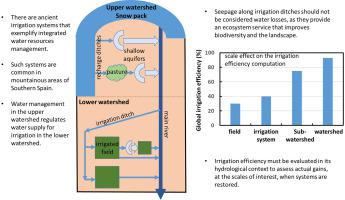Agricultural Systems ( IF 6.1 ) Pub Date : 2022-09-13 , DOI: 10.1016/j.agsy.2022.103513 Nicolás A. Oyonarte , Helena Gómez-Macpherson , Sergio Martos-Rosillo , Antonio González-Ramón , Luciano Mateos

|
CONTEXT
In the Middle Ages, the Muslims introduced communal water management in the Iberian Peninsula. Some irrigation systems of medieval origin are still in operation in the mountainous areas of Southern Spain. Snowmelt runoff is diverted during spring from high-altitude streams into contoured recharge ditches that convey the water to areas of high infiltration (shallow aquifers). This regulates and delays discharge into the main river, from which downstream flow is diverted, during late spring and summer, to irrigation ditches that supply terraces and fields on river plains. The Busquístar irrigation ditch and its irrigation scheme comprise one of these ancient systems.
OBJECTIVES
1) To characterize the Busquístar system, its water source and regulation, its water users' association, its multi-functionality, and its quality as a nature-based solution for water security. 2) To review the irrigation efficiency concept applied to the restoration of ancient irrigation systems, taking into account their ecosystem services.
METHODS
i) Semi-structured interviews with stakeholders to evaluate irrigation system operation and perceptions of multi-functionality; ii) field surveys for description of the irrigation ditch and its riparian flora; iii) satellite imagery for quantifying riparian vegetation; iv) water balance for irrigation efficiency computation.
RESULTS AND CONCLUSIONS
Crop production is the main function of the Busquístar irrigation scheme but additional ecosystem services are creation of landscape and biodiversity. Eight riparian plant communities were distinguished along the irrigation ditch. The discharge measured at its head on 23 July and 3 September 2017 represented 14 and 50% of the mean river flow in July and September, respectively. The flow measured at the first bifurcation of the ditch was about half that at the head, revealing the proportion filtered along its 6470-m long conveyance reach. The remaining flow was then diverted to 4 branches along the 3140-m long distribution reach proportionally to the irrigable area in each branch. Return flows and irrigation efficiency were estimated for the two measuring dates considering riparian and crop evapotranspiration. The estimated efficiency was highly dependent on which water uses were considered beneficial and on the scale of analysis, field, entire system or watershed.
SIGNIFICANCE
The study revealed the integrated approach behind the traditional water management in these ancient systems. The article proposes a review of the irrigation efficiency concept that allows reconciling the character of a nature-based solution with the current restoration of the system, responding to the needs of the emerging export horticulture in the area.
中文翻译:

在恢复多功能、基于自然的水系统中的古代灌溉渠之前重新审视灌溉效率
语境
在中世纪,穆斯林在伊比利亚半岛引入了公共水资源管理。一些中世纪起源的灌溉系统仍在西班牙南部的山区运行。春季融雪径流从高海拔溪流转移到等高的补给沟渠,将水输送到高渗透区域(浅含水层)。这调节和延迟了向主要河流的排放,在春末和夏季,下游水流从主要河流转移到灌溉沟渠,为河流平原上的梯田和田地供水。Busquístar 灌溉沟渠及其灌溉方案构成了这些古老系统之一。
目标
1) 描述 Busquístar 系统、它的水源和监管、它的用水户协会、它的多功能性以及它作为基于自然的水安全解决方案的质量。2) 审查适用于恢复古代灌溉系统的灌溉效率概念,并考虑其生态系统服务。
方法
i) 与利益相关者进行半结构化访谈,以评估灌溉系统的运行和对多功能性的看法;ii) 实地调查,以描述灌溉沟渠及其河岸植物群;iii) 用于量化河岸植被的卫星图像;iv) 灌溉效率计算的水平衡。
结果和结论
作物生产是 Busquístar 灌溉计划的主要功能,但额外的生态系统服务是创造景观和生物多样性。沿灌溉渠划分出八个河岸植物群落。2017 年 7 月 23 日和 9 月 3 日在水头测量的流量分别占 7 月和 9 月平均河流流量的 14% 和 50%。在沟渠第一个分叉处测得的流量约为头部的一半,揭示了沿其 6470 米长输送范围过滤的比例。然后,剩余的水流沿 3140 米长的分布范围转移到 4 个分支,与每个分支的可灌溉面积成比例。考虑河岸和作物蒸散,估计了两个测量日期的回流和灌溉效率。
意义
该研究揭示了这些古老系统中传统水资源管理背后的综合方法。本文提出了对灌溉效率概念的审查,该概念允许协调基于自然的解决方案的特征与当前的系统恢复,以响应该地区新兴出口园艺的需求。











































 京公网安备 11010802027423号
京公网安备 11010802027423号